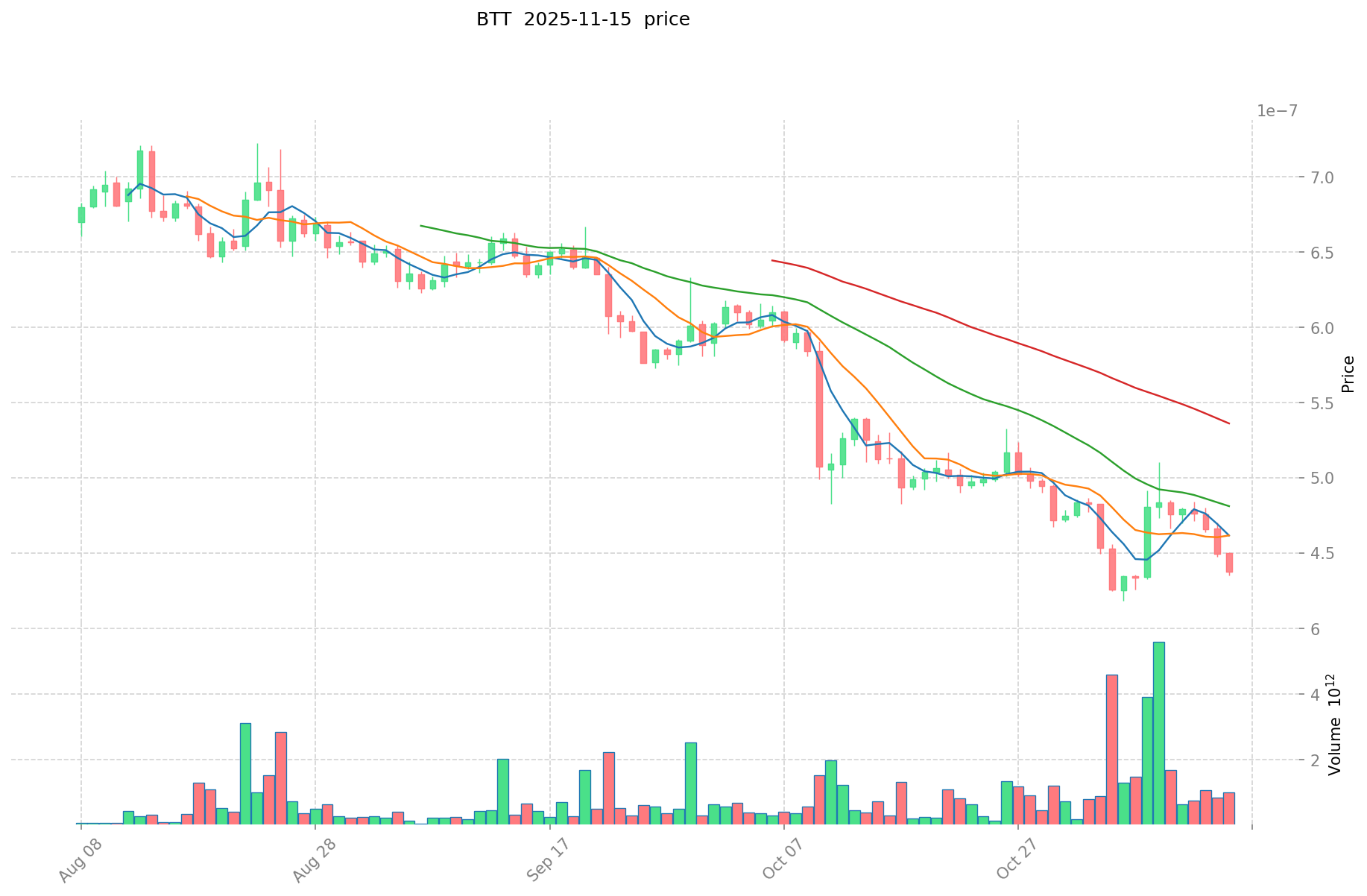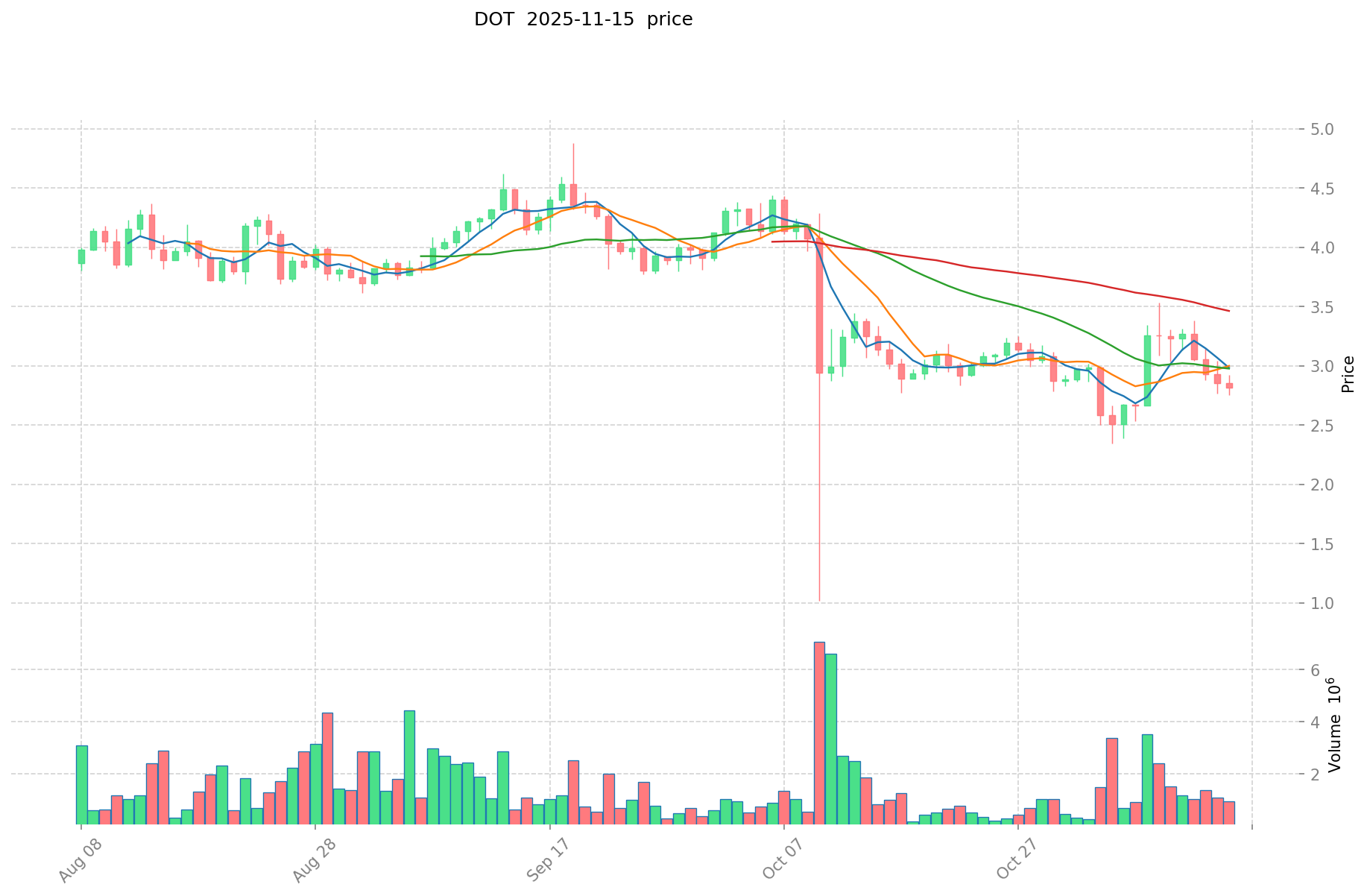BTT vs DOT: Comparing Two Blockchain Platforms for Decentralized Applications
Introduction: BTT vs DOT Investment Comparison
In the cryptocurrency market, BitTorrent (BTT) vs Polkadot (DOT) comparison has always been an unavoidable topic for investors. The two not only have significant differences in market cap ranking, application scenarios, and price performance, but also represent different positioning in crypto assets.
BitTorrent (BTT): Since its launch in 2019, it has gained market recognition for its decentralized file sharing and content distribution capabilities.
Polkadot (DOT): Introduced in 2020, it has been hailed as the "Internet of Blockchains," becoming one of the most prominent projects in the blockchain interoperability space.
This article will comprehensively analyze the investment value comparison between BTT and DOT, focusing on historical price trends, supply mechanisms, institutional adoption, technological ecosystems, and future predictions, attempting to answer the question investors care about most:
"Which is the better buy right now?"
I. Price History Comparison and Current Market Status
BitTorrent (BTT) and Polkadot (DOT) Historical Price Trends
- 2022: BTT reached its all-time high of $0.00000343 on January 21, 2022.
- 2023: DOT hit its all-time low of $2.13 on October 11, 2023.
- Comparative analysis: During the market cycle, BTT dropped from its peak of $0.00000343 to a low of $0.000000365368, while DOT declined from its all-time high of $54.98 to $2.13.
Current Market Situation (2025-11-15)
- BTT current price: $0.0000004429
- DOT current price: $2.899
- 24-hour trading volume: BTT $306,881.35 vs DOT $2,470,528.60
- Market Sentiment Index (Fear & Greed Index): 10 (Extreme Fear)
Click to view real-time prices:
- Check BTT current price Market Price
- Check DOT current price Market Price


II. Core Factors Affecting Investment Value of BTT vs DOT
Supply Mechanism Comparison (Tokenomics)
-
BTT: BitTorrent has a maximum supply cap of 990,000,000,000 BTT, with deflationary mechanisms through token burns
-
DOT: Polkadot has an inflationary model with no maximum supply cap, with new DOT tokens being issued as staking rewards
-
📌 Historical Pattern: Deflationary models like BTT's tend to create price pressure during high demand periods, while DOT's inflationary approach focuses on incentivizing network security through staking.
Institutional Adoption and Market Applications
- Institutional Holdings: DOT appears to have stronger institutional backing through strategic investments from Web3 Foundation and participation from established venture capital firms
- Enterprise Adoption: DOT has gained more enterprise traction through its parachain ecosystem and cross-chain interoperability solutions, while BTT focuses more on content distribution applications
- Regulatory Attitudes: Both tokens face varying regulatory treatment across jurisdictions, with neither having clear regulatory advantages globally
Technical Development and Ecosystem Building
- BTT Technical Upgrades: Integration with the TRON ecosystem and BitTorrent Speed for incentivized file sharing
- DOT Technical Development: Continuous development of parachains, cross-consensus messaging (XCM), and Substrate framework for blockchain building
- Ecosystem Comparison: DOT has a more diverse ecosystem spanning DeFi, NFTs, and smart contract applications through its parachain model, while BTT is more focused on specific use cases within content distribution and file sharing
Macroeconomic and Market Cycles
- Inflation Performance: DOT's governance and utility in the Polkadot ecosystem potentially offers more inflation hedging properties compared to BTT
- Macroeconomic Monetary Policy: Both tokens show sensitivity to broader market conditions and Federal Reserve policies, with risk assets like cryptocurrencies generally moving in correlation
- Geopolitical Factors: DOT's focus on interoperability may provide advantages in an increasingly fragmented global blockchain landscape
III. 2025-2030 Price Prediction: BTT vs DOT
Short-term Prediction (2025)
- BTT: Conservative $0.000000372204 - $0.0000004431 | Optimistic $0.0000004431 - $0.00000053172
- DOT: Conservative $1.85664 - $2.901 | Optimistic $2.901 - $3.24912
Mid-term Prediction (2027)
- BTT may enter a growth phase, with expected prices ranging from $0.000000501033109 to $0.000000641772747
- DOT may enter a consolidation phase, with expected prices ranging from $2.66607702 to $4.328454456
- Key drivers: Institutional fund inflows, ETF, ecosystem development
Long-term Prediction (2030)
- BTT: Base scenario $0.000000841738528 - $0.000000914933183 | Optimistic scenario $0.000000914933183 - $0.000001253458461
- DOT: Base scenario $4.051418895586062 - $4.3100201016873 | Optimistic scenario $4.3100201016873 - $5.60302613219349
Disclaimer
BTT:
| 年份 | 预测最高价 | 预测平均价格 | 预测最低价 | 涨跌幅 |
|---|---|---|---|---|
| 2025 | 0.00000053172 | 0.0000004431 | 0.000000372204 | 0 |
| 2026 | 0.0000006385071 | 0.00000048741 | 0.0000004094244 | 10 |
| 2027 | 0.000000641772747 | 0.00000056295855 | 0.000000501033109 | 27 |
| 2028 | 0.000000897524816 | 0.000000602365648 | 0.000000391537671 | 36 |
| 2029 | 0.000001079921134 | 0.000000749945232 | 0.000000697449066 | 69 |
| 2030 | 0.000001253458461 | 0.000000914933183 | 0.000000841738528 | 106 |
DOT:
| 年份 | 预测最高价 | 预测平均价格 | 预测最低价 | 涨跌幅 |
|---|---|---|---|---|
| 2025 | 3.24912 | 2.901 | 1.85664 | 0 |
| 2026 | 3.1980624 | 3.07506 | 2.9520576 | 6 |
| 2027 | 4.328454456 | 3.1365612 | 2.66607702 | 8 |
| 2028 | 4.51633447188 | 3.732507828 | 2.83670594928 | 28 |
| 2029 | 4.4956190534346 | 4.12442114994 | 2.1446989979688 | 42 |
| 2030 | 5.60302613219349 | 4.3100201016873 | 4.051418895586062 | 48 |
IV. Investment Strategy Comparison: BTT vs DOT
Long-term vs Short-term Investment Strategies
- BTT: Suitable for investors focused on content distribution and file-sharing applications
- DOT: Suitable for investors interested in blockchain interoperability and ecosystem development
Risk Management and Asset Allocation
- Conservative investors: BTT: 20% vs DOT: 80%
- Aggressive investors: BTT: 40% vs DOT: 60%
- Hedging tools: Stablecoin allocation, options, cross-currency portfolio
V. Potential Risk Comparison
Market Risks
- BTT: Higher volatility, susceptible to speculative trading
- DOT: Sensitive to overall crypto market trends, competition from other interoperability projects
Technical Risks
- BTT: Scalability, network stability
- DOT: Parachain auction dynamics, potential security vulnerabilities in cross-chain operations
Regulatory Risks
- Global regulatory policies may impact both tokens differently, with DOT potentially facing more scrutiny due to its broader ecosystem approach
VI. Conclusion: Which Is the Better Buy?
📌 Investment Value Summary:
- BTT advantages: Established file-sharing use case, deflationary tokenomics
- DOT advantages: Strong institutional backing, diverse ecosystem, interoperability focus
✅ Investment Advice:
- New investors: Consider a higher allocation to DOT due to its more established ecosystem and institutional support
- Experienced investors: Balanced approach with a slight bias towards DOT, but include BTT for diversification
- Institutional investors: Focus on DOT for its broader market applications and potential for enterprise adoption
⚠️ Risk Warning: The cryptocurrency market is highly volatile, and this article does not constitute investment advice. None
VII. FAQ
Q1: What are the main differences between BTT and DOT? A: BTT focuses on decentralized file sharing and content distribution, while DOT is designed for blockchain interoperability. BTT has a maximum supply cap and deflationary mechanisms, whereas DOT has an inflationary model with no supply cap.
Q2: Which token has shown better price performance historically? A: Historically, DOT has shown better price performance. While BTT reached its all-time high of $0.00000343 in January 2022, DOT's all-time high was $54.98. However, both tokens have experienced significant price declines since their peaks.
Q3: How do institutional adoption and market applications compare between BTT and DOT? A: DOT appears to have stronger institutional backing and more enterprise adoption through its parachain ecosystem and cross-chain interoperability solutions. BTT, on the other hand, focuses more on specific use cases within content distribution and file sharing.
Q4: What are the potential risks associated with investing in BTT and DOT? A: BTT faces higher volatility and is more susceptible to speculative trading. DOT is sensitive to overall crypto market trends and faces competition from other interoperability projects. Both tokens are subject to regulatory risks, with DOT potentially facing more scrutiny due to its broader ecosystem approach.
Q5: Which token is considered a better long-term investment? A: Based on the analysis, DOT is generally considered a better long-term investment due to its strong institutional backing, diverse ecosystem, and focus on interoperability. However, investors should consider their own risk tolerance and investment goals when making decisions.
Q6: How do the future price predictions for BTT and DOT compare? A: Long-term predictions for 2030 suggest that BTT may reach between $0.000000841738528 and $0.000001253458461, while DOT is expected to range from $4.051418895586062 to $5.60302613219349. However, these predictions are speculative and subject to market conditions.
Q7: What allocation strategy is recommended for investors interested in both BTT and DOT? A: For conservative investors, a suggested allocation is 20% BTT and 80% DOT. For aggressive investors, the recommendation is 40% BTT and 60% DOT. New investors may consider a higher allocation to DOT due to its more established ecosystem and institutional support.
Share
Content